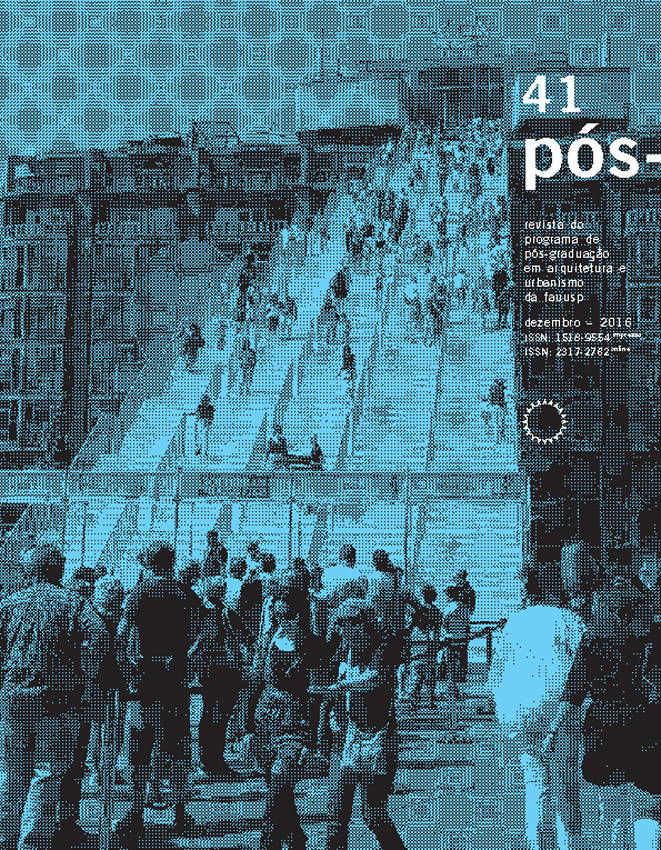Ilha urbana de calor superficial e a energia das edificações: visualização dos fluxos do clima urbano
DOI:
https://doi.org/10.11606/issn.2317-2762.v23i41p122-139Palavras-chave:
Ilha de calor. MODIS. Morfologia urbana. Medição remota. GIS.Resumo
O efeito de ilha de calor urbana superficial (SUHI) pode ser definida como o aquecimento relativo da temperatura das superficies nas cidades comparado com o do entorno dessas cidades devido as respectivas diferenças nas taxas de resfriamento. Estudos clássicos demonstraram que o aquecimento urbano é um fenômeno regional e ocasional, cuja ocorrência depende de condições de clima e das características do tecido urbano. Imagens de satélite e de GIS são combinadas nesse artigo para revelar padrões de variações térmicas nas cidades e relacionar temperatura do ar com densidade construída e taxa de ocupação. Seis regiões de cidades européias foram selecionadas: Madri (40ºN, 3ºE), Colonia (50ºN, 6ºE), Barcelona (41ºN,2ºE) Londres (51ºN,0.5ºW), Bruchelas (50ºN,4ºE) e Berlim (52ºN,13ºE). Imagens com informação sobre temperaturas superficiais foram obtidas da base de dados Modis Satélite. Mais de 120 arquivos foram análisados para selecionar seis dias e noites de verão. Seis noites de verão são apresentadas aqui, pois oferecem a visão mais clara da distribuição de temperaturas superficiais. A correlação espacial entre temperatura do ar, densidade e taxa de ocupação urbana foi analisada em GIS e marcadas em cortes do espaço da cidade. A correlação mais forte encontrada foi entre a densidade e a taxa de ocupação. Finalmente, a influência da Ilha Urbana de Calor (SUHI) na demanda energética das edificações em Londres e Barcelona foram investigadas. A análise mostrou um impacto significativo desse fenômeno em regiões de clima mais quente.
Downloads
Referências
ARNFIELD, A.J. Two decades of urban climate research: a review of turbulence exchanges of energy and water, and the urban heat island. International Journal of Climatology, 23 1-26, 2003.
BARRY, R.G. and CHORLEY, R.J. (8th ed.) Atmosphere, Weather and Climate. Routledge, 2003.
CABRITA, A.L. and XXX-XXX (MASKED FOR BLIND REVIEW), J. BREEAM Communities in Spain. In BREBBIA, C.A. (2011) The Sustinable World. WIT Press, Southampton, 2011.
CHANDLER, T.J. The Climate of London. Hutchinson. London, 1965.
CHAO, R. NG, E.Y. KATZSCHNER, L. Urban climatic map studies: a review. International Journal of Climatology (31) 15: 2213-2233, 2010.
DOUGLAS, I. The Urban Environment. Arnold.London, 1983.
EARTH EXPLORER (2013). Disponível em:: http://earthexplorer.usgs.gov/. Acesso em: 6 maio 2013.
EDWARDS, B. (3rd ed.) Rough Guide to Sustainability. A Design Primer. RIBA Publishing, 2010.
ELIASSON, I. The use of climate knowledge in urban planning. Landscape and Urban Planning 48:31-44, 2000.
EUROPEAN ENVIRONMENT AGENCY (2013a) Population density disaggregated with Corine land cover 2000. Disponível em: www.eea.europa.eu/data-and-maps/data/population-density-disaggregated-with-corine-land-cover-2000-2. Acesso em: 6 maio 2013.
EUROPEAN ENVIRONMENT AGENCY (2013b) Urban Atlas. Disponível em: www.eea.europa.eu/data-and-maps/data/urban-atlas. 6 maio 2013.
FOLEY, J. A. et al. Global Consequenes of Land Use. In Science (309):570-574, 2005.
GRIMMOND, S. London's Urban Climate: Historical and Contemporary Perspectives. City Weathers: Meteorology and Urban Design 1950-2010. Manchester Architecture Research Centre. 23-24 June 2011. University of Manchester, 2011.
HARTMANN, F.L. et al. Observations: Atmosphere and Surface. In: Climate Change 2013: The Physical Science Basis. Contribution of Working Group I to the Fifth Assessment Report of the Intergovernmental Panel on Climate Change. Cambridge University Press, Cambridge, UK and New York, USA, 2013.
HOUGH, M. Cities and Natural Processes: A Basis for Sustainability. New York. Routledge, 2004.
ICHINOSE, T. Shimodozono, K. & HANAKI, K. (1999) Impact of anthropogenic heat or urban climate in Tokyo. Atmospheric Environment n.33 pp.3897-3909. Pergamon
LANDSBERG,H.E. The Urban Climate. New York Academic Press, 1981.
LITTLEFAIR, P.J. SANTAMOURIS, M. ALVAREZ, S. DUPAGNE, A. HALL, D. TELLER, J. CORONEL, J.F. PAPANIKOLAU, N. Environmental Site Layout Planning: Solar Access, Microclimate and Passive Cooling in Urban Areas. Construction Research Communications, 2000.
LYNCH, K. Good City Form. The MIT Press, 1981.
METEONORM. Global Meteorological Database, 2013.
OKE, T.R. (2011). Urban Heat islands. In Douglas, I. Goode, D. Houck, M. & Wang, R. The Routledge Handbook of Urban Ecology. Routledge Handbooks, 2011.
OKE, T.R. Boundary Layer Climates. Methuen & Co., London. 1987.
OKE, T.R. Towards a prescription for the greater use of climatic principles in settlement planning. Energy and Buildings (7) 1:1-10, 1984.
ROAF, S. Crichton, D. and NICOL, F. eds. Adapting Buildings and Cities For Climate Change. A 21st Century Survival Guide. Architectural Press. London.2009.
RODRÍGUEZ-ALVAREZ, J. Planning Cities for the Post-Carbon Age. A Metabolic Analysis of the Urban Form. PhD Thesis. University of A Coruña, 2014.
SATELLITE AQUA, (2013). Disponível em: www.aqua.nasa.gov. Acesso em: 6 maio 2013.
SCHILLER, S. and EVANS, J.M. Bridging the gap between climate and design at the urban and building scale: research and application. Energy and Buildings 15-16: 51-55, 1991.
SPIRN, A. W. The Granite Garden. Urban Nature and Human Design. Harper Collins Publishers, 1984.
STOCKER, T.F. et al. Technical Summary. In : Climate Change 2013. The Physical Science Basis. Contribution of Working Group I to the Fifth Assessment Report of the Intergovernmental Panel on Climate Change. Cambridge University Press, Cambridge, UK and New York, USA, 2013.
VOOGT, J.A. and OKE, T.R. Thermal remote sensing of urban climates. Remote Sensing of the Environment, 86: 370-384, 2003.
WATSON, R.T. Zinyowera, M.C: and Moss, R.HThe Regional Impacts of Climate Change: An Assessment of Vulnerability. Cambridge University Press, UK, 1997.
Downloads
Publicado
Edição
Seção
Licença
O detentor dos direitos autorais é o autor do artigo. A revista exige apenas o ineditismo na publicação do artigo. O autor tem do direito de divulgar seu artigo conforme sua conveniência devendo citar a revista.
DIADORIM - Diretório de Políticas Editoriais












